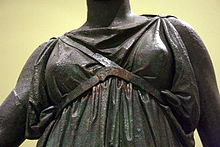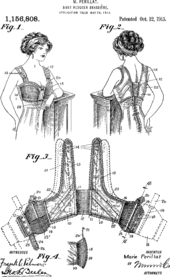History of bras
The history of bras (brassières; variously pronounced) is closely tied to the social status of women, the evolution of fashion, and shifting views of the female body over time.[6] However, it is unknown if the stróphion was an everyday garment worn by the average woman or an item of clothing reserved for certain situations or specific types of women.The Roman adaptation of the strophium was mentioned in writings by Martial, Ovid, and in the Scriptores Historiae Augustae as the fascia, fasciola, taenia, or mamillare.[16] American women who made important contributions to the corset reform movement included Amelia Bloomer and Dr. Mary Edwards Walker."[25] In 1893, Marie Tucek received a U.S. patent for a device that consisted of separate pockets for each breast above a metal supporting plate, with shoulder straps fastened by hook-and-eye.Advertising of the times, typically in periodicals, stressed the advantages of bras in health and comfort over corsets and portrayed garments with shoulder supports in a mono-bosom style and with limited adaptability.[31] In 1910, Mary Phelps Jacob (known later in life as Caresse Crosby), a 19-year-old New York socialite, purchased a sheer evening gown for a debutante ball.[34][35][36]: 54 Crosby's patent was for a lightweight, soft, and comfortable device that naturally separated the breasts; in contrast with the corset, which was heavy, stiff, uncomfortable, and had the effect of creating a "monobosom".Bras became more common and widely promoted throughout the 1910s, aided by the continuing trend towards lighter, shorter corsets that offered increasingly less bust support and containment.Thus the bra emerged from something that was once discreetly tucked into the back pages of women's magazines in the 1890s to prominent display in department stores such as Sears, Roebuck, and Montgomery Ward by 1918.The term flapper, which in the mid-1910s referred to pre- and early-teenage girls, was adopted by the J. Walter Thompson advertising agency in the 1920s for their younger adult customers.Other major manufacturers of the 1930s included Triumph, Maidenform, Gossard (Courtaulds), Spirella, Spencer, Twilfit, and Symington.World War II had a significant impact on clothing.Willson Goggles, a Pennsylvania firm manufacturing safety equipment for manual workers, is believed to have introduced the plastic "SAF-T-BRA", designed to protect women on the factory floor.Dress codes appeared – for example, Lockheed informed their workers that bras must be worn because of "good taste, anatomical support, and morale."Advertising in the 1940s appealed to patriotism and the concept that bras and girdles were somehow "protection".Advertising, promotion, and consumerism started to be directed at minorities (e.g., Ebony in 1945) and teens Military terminology crept into product marketing, as represented by the highly structured, conically pointed Torpedo or Bullet bra designed for "maximum projection".As in World War I, there was concern about the use of badly needed steel in corsets; in 1941, the British Government carried out a survey of women's usage of underwear that showed that "on average, women-owned 1.2 bras (housewives 0.8 and agricultural workers 1.9).[46] Before introducing training bras, young girls in Western countries usually wore a one-piece "waist" or camisole without cups or darts.His minimalist bra was a revolutionary departure from the heavy, torpedo-shaped bras of the 1950s and initiated a trend toward more natural shapes and soft, sheer fabrics.[48][49] He also designed the "All-in-None" with a deep, plunging front and the "No-Back" long-line version, which featured a contoured stretch waistband that allowed a woman to wear a backless dress.Lindahl and her sister, Victoria Woodrow, complained about their bad experience exercising in ordinary bras, having experienced runaway straps, chafing, and sore breasts.[57][58] Starting in 1994, manufacturers re-focused advertising, moving from the functionality of support and foundation to selling fashion lingerie, often with impractical additions such as scratchy lace.[59] Notably, Victoria's Secret became popular with its sexy ads featuring supermodels Alessandra Ambrosio, Tyra Banks, Gisele Bundchen, Naomi Campbell, Laetitia Casta, Helena Christensen, Eva Herzigova, Heidi Klum, and Adriana Lima.On the one hand, there was a demand for minimal bras that allow plunging necklines and reduce interference with the lines of outer garments, such as the shelf bra.[67] Some have attributed the rising popularity of bralettes to a new focus on the "athletic body, health and wellbeing" rather than "the male gaze",[68] while others suggest a connection to the #MeToo movement.[72][73] A local newspaper story reported that bras and other lingerie were burned at least briefly that day, noting, "As the bras, girdles, falsies, curlers, and copies of popular women’s magazines burned in the Freedom Trash Can, the demonstration reached the pinnacle of ridicule when the participants paraded a small lamb wearing a gold banner worded Miss America."[94] In 2005, feminist author Iris Marion Young wrote that the bra "serves as a barrier to touch" and that a braless woman is "deobjectified", eliminating the "hard, pointy look that phallic culture posits as the norm."[94] In 2007, Young wrote that women are subjected to "capitalist, patriarchal American media-dominated culture [that] objectifies breasts before such a distancing glance that freezes and masters.[95] While the modern era has evolved almost directly from the proto-bra of the Middle Ages, Asian cultures have invented garments that serve similar purposes.[96][97] The most well-known example is the dudou (Chinese: 肚兜, 兜肚, or 兜兜; also known by other names), a diamond-shaped garment used to flatten the breasts and preserve the stomach qi, which was developed in the Qing dynasty.Other similar items of clothing include: The first historical reference to breast-support garments in India is found during the rule of King Harshavardhana (1st century CE).












ArtemisPompeiibreastsMinoan civilizationbikiniGreco-Roman periodcorsetWestern worldgirdleWorld War IGirdle of AphroditeAncient GreeceHomer'sarchaic period of classical antiquityAphrodite'sAncient GreekAristophanesLysistrataWomen at the ThesmophoriaMartialScriptores Historiae AugustaeVilla Romana del CasaleHigh Middle AgesHenri de MondevilleKing Phillip the Fair of FranceLengberg CastleAustriaHistory of corsetsFrench16th centuryfarthingalebaleenVictorian dress reformAmelia BloomerMary Edwards WalkerUnited KingdomConstance LloydOscar WildeBrooklyn, New YorkCamden, New JerseyMassachusetts Charitable Mechanics AssociationCotton States and International ExpositionWorld's Columbian ExpositionHerminie CadolleExposition Universelleelasticunderwire branegligéestraight-fronted corsetbodicescamisolesbrassierepatent applicationOxford English DictionaryStuttgartBad CannstattBöblingen, GermanyCaresse Crosbydebutante ballU.S. Patent OfficeHarry CrosbyWarners BrothersBridgeport, ConnecticutU.S. War Industries BoardSears, RoebuckMontgomery WardflapperJ. Walter ThompsonandrogynousIda RosenthalMaiden FormlactationHarper's BazaarHollywood glamourmarketingCourtauldsSpirellaWorld War IILockheedgirdlesMilitary terminologyTorpedo or Bullet braPin-upssweater girlsPatti Pagebaby boomnursing braspubertytraining brascamisolemastectomyRudy GernreichExquisite FormWonderbraLisa LindahlHinda SchreiberjockstrapUniversity of VermontSmithsonianNew York Metropolitan Museum of Artsilicone breast implantsVictoria's SecretAlessandra AmbrosioTyra BanksGisele BundchenNaomi CampbellLaetitia CastaHelena ChristensenEva HerzigovaHeidi KlumAdriana LimaHanesBrands Inc.BerleiMadonnabralettesunderwiredMarks & Spencermale gazeCOVID-19 lockdownsBralessnessMiss America protestVietnam Warburned their draft cardsRobin MorganCarol Hanischmasculism